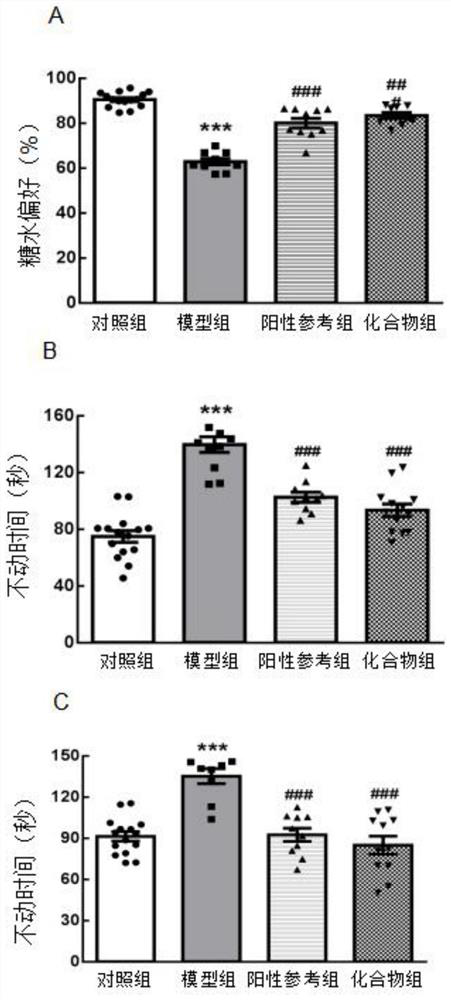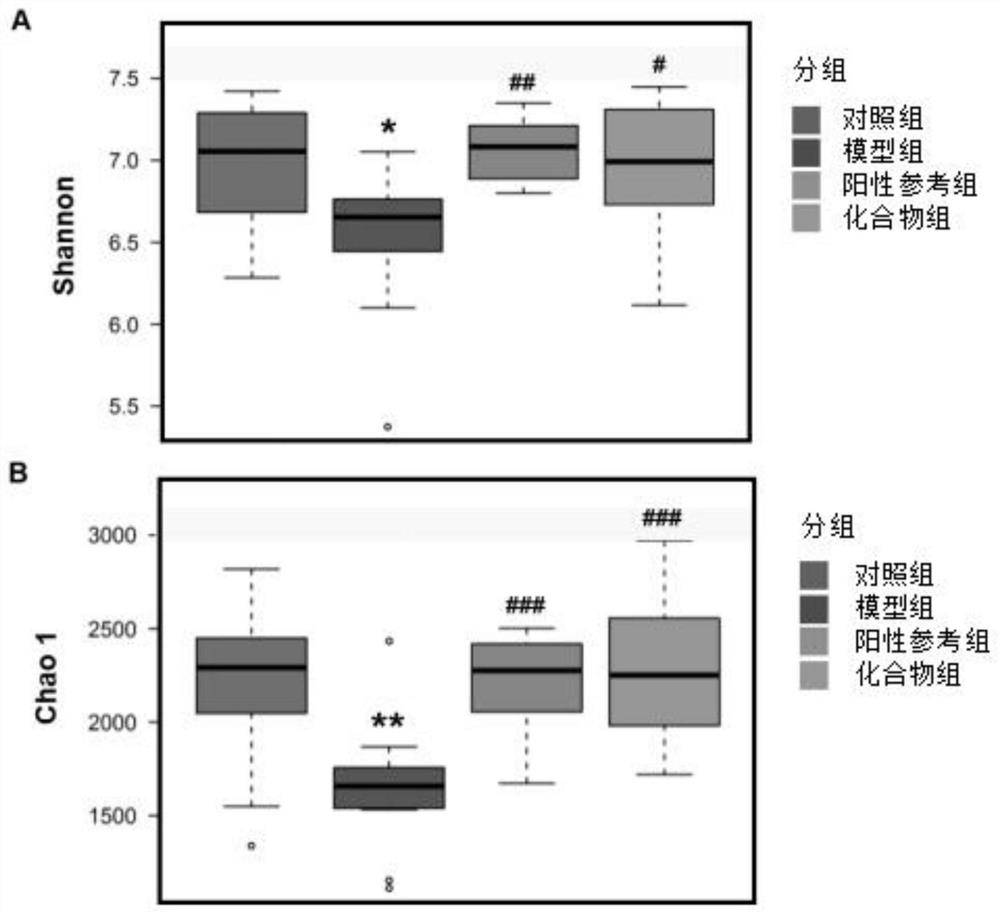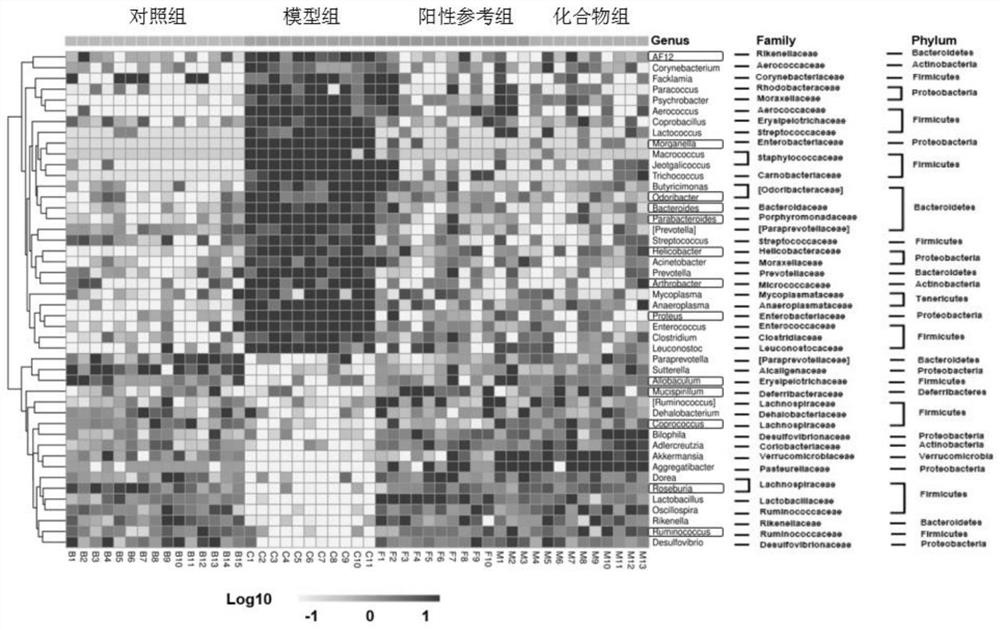Application of a 1-benzhydryl-4-methylpiperazine compound in the preparation of antidepressant drugs
A benzhydryl compound technology, applied in the field of medicine, can solve the problems of inconclusive mechanism and complex pathogenesis of depression, and achieve the effect of improving intestinal flora disorder and symptoms of depression
- Summary
- Abstract
- Description
- Claims
- Application Information
AI Technical Summary
Problems solved by technology
Method used
Image
Examples
Embodiment 1
[0025] The establishment of the mouse chronic unpredictable stress model of embodiment 1:
[0026] A mouse model of chronic unpredictable stress was established by exposing mice to various randomly scheduled low-intensity social and environmental stressors 1-2 times a day for 4 weeks.
[0027] Random stressors included: 1) restraint for 6 hours; 2) cage tilting at 45° along a vertical axis for 3 hours; 3) water and food deprivation (for 24 hours, then normal afterward); 4) circadian light reversal; 5) no pad 6) Tail clamping for 1 minute (1 cm from the base of the tail); 7) Wet litter for 24 hours; 8) Forced swimming at 8°C for 5 minutes.
[0028] Experimental group:
[0029] 1) Control group: control mice;
[0030] 2) Model group: the above-mentioned chronic unpredictable stress model was used for modeling;
[0031] 3) Positive reference group: Fluoxetine was used as the positive reference drug, administered by intraperitoneal injection, 10 mg / kg / day, for 4 weeks;
[0032...
Embodiment 2
[0033] Embodiment 2 sucrose preference test
[0034] The sucrose preference test was conducted in three phases: the first phase habituation, the second phase sucrose preference baseline, and the third phase sucrose preference test. Phase 1: Mice are acclimatized with sucrose at a concentration of 1%. The second stage: each mouse was reared in a single cage, and the mice were given the same amount of normal drinking water and 1% sucrose solution, and the positions of the normal drinking water and sucrose water bottles were changed every 6 hours. The consumption of normal drinking water and 1% sucrose solution was recorded for 24 hours, and the sucrose baseline of the animals was calculated. In the third stage, each mouse was reared in a single cage, and the mice were given the same amount of normal drinking water and 1% sucrose solution, and the positions of the normal drinking water and sucrose water bottles were changed every 6 hours. The consumption of normal drinking wate...
Embodiment 3
[0037] Embodiment 3 Tail Suspension Experiment Test
[0038] During the tail suspension test, the mice were suspended on the top of the equipment box 50 cm above the ground. The experiment time is 6 minutes, the first 2 minutes is the adaptation time of the mice, and the last 4 minutes is the test time. The immobility time of the mice within 4 min after recording was recorded.
[0039] Immobility time: the mouse is in a suspended state without any body movements. Immobility time was measured using the ANY maze tracking system (Stoelting Co, Wood Dale, Illinois).
[0040] Results: The immobility time of the mice in the model group increased significantly, and the compound 1-benzhydryl-4-((1-phenyl-1H-1,2,3-triazol-4-yl)methyl)piperazine It can significantly reduce the immobility time of mice and alleviate the depression-like symptoms of mice, and the effect is consistent with that of the positive reference drug fluoxetine.
PUM
| Property | Measurement | Unit |
|---|---|---|
| diameter | aaaaa | aaaaa |
Abstract
Description
Claims
Application Information
 Login to View More
Login to View More - R&D
- Intellectual Property
- Life Sciences
- Materials
- Tech Scout
- Unparalleled Data Quality
- Higher Quality Content
- 60% Fewer Hallucinations
Browse by: Latest US Patents, China's latest patents, Technical Efficacy Thesaurus, Application Domain, Technology Topic, Popular Technical Reports.
© 2025 PatSnap. All rights reserved.Legal|Privacy policy|Modern Slavery Act Transparency Statement|Sitemap|About US| Contact US: help@patsnap.com



